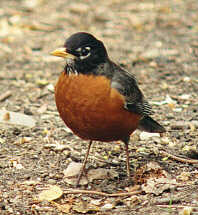The City Naturalist
American Robin
 Article
and Photos by Leslie Day
Article
and Photos by Leslie Day
AMERICAN ROBIN: Turdus migratorius (Genus name: Latin for Thrush, species name from Latin for migrator, wanderer). Other common names: Canada robin, common robin, migratory thrush, northern robin, robin redbreast.
LOCALLY: On March 12, 1997 we spotted our first pair of Robins of the season here in Riverside Park. We have read that in mid March, when there are equal hours of daylight and darkness, one starts to see the return of Robins up north. Usually the males migrate north first, followed by the females several weeks later. However, the two Robins spotted just outside the tunnel at the 73rd Street exit from the lower park to the upper park, were a male and a female, hunting for worms underneath the Hawthorne trees.
DESCRIPTION: Both sexes have grayish-brown backs, yellow bills, and brick-red chest, but the male's is a deeper red. The male has a dark, almost black top of the head, wings and tail, while the female is duller. Immature Robins have spots on their chests. Typically, Robins are about 10 inches long with a 16 inch wingspan.
VOICE: The males begin singing their joyous, liquid song to attract a mate. This caroling begins in April when the females return- a familiar cheer-up, cheer, cheer, cheer-up.
NESTING: Once the females migrate north, the males strike out nesting territories and fight for mates. The nesting pair immediately start building a nest, usually in a low tree or shrub, 5 to 15 feet above the ground. We have seen many Robin's nests in the crabapple trees that line the Hudson River from 72nd Street to 83rd Street. After building a bottom layer or platform of twigs and grass, the Robins build up the walls with mud and more grass. Then the female gets in the nest and, turning round and round inside the cup, she smooths and shapes the inner walls with her breast and half-extended wings and adds a lining of soft grass. Since Robins often build their nests within view, if you start to look for nests you might see this interesting process in April.
INCUBATION: The female sits on the eggs, which are "Robin's egg blue" (a now accepted color standard), for almost 2 weeks while her mate stands guard. As soon as the baby birds hatch, both parents hunt for insects from dawn to dusk, making hundreds of trips back and forth to the nest with food for their hungry nestlings. The juveniles leave the nest after about 2 weeks, when they are well, though not fully feathered, and show the spotted breast of the juvenile. These spots are the markings that tell us that Robins are part of the Thrush family of birds. When the fledglings first leave the nest they are in danger of being attacked by other animals, because they do not have their full compliment of flight feathers, which take another few days to develop. During this time, their parents watch them and continue to feed them and bring water to them on the ground. By the time the fledglings are two weeks old, they are fully feathered and go off on their own. It is then that their parents start another family. During the breeding season a pair of Robins will raise two or sometimes three broods.
Many people, who find baby Robins fear that they have fallen out of the nest and take them home. It is best to leave them where they are, under the watchful eyes of their parents. Or if you fear they may be attacked by cats or dogs, or hit by a car or bicycle, you can pick them up and put them back in the nest if you can reach it. Contrary to popular belief, the parents will not abandon baby birds that have been touched by humans. There is a veterinarian's office nearby, Westside Vet on West 83rd Street between Broadway and Amsterdam, that will take in baby birds, feed them and return them to the park when their flight feathers come in for a modest fee of $15 (their "Pigeon Fund").
FOOD: It is common to see Robins running across lawns in search of earthworms. With their heads cocked toward the ground, almost as if listening for worms, the Robin will suddenly strike with its bill and pull an earthworm from the ground. Ornithologists now know that Robins use their keen eyesight to find birds, not their hearing. Robins also eat insects such as beetles, weevils, grasshoppers, cicadas, ants, termites, caterpillars, and butterflies. They eat fruit such as pokeberries, bayberries, grapes, Juneberries, mistletoe berries and chinaberries. If you throw some bread out, Robins will eat this too.
HABITAT: City parks, suburban gardens, rural farmlands and gardens, orchards, forests, golf courses.
RANGE: Nests throughout North America from the northern tree line of Alaska and Canada, south to Southern California, the Gulf Coast and Mexico. Robins winter mainly south of Canada in berry-bearing trees, to as far south as Guatemala.
AGE: One banded wild Robin lived to almost 12 years. Captive Robins have been known to live 17 years.
FLIGHT SPEED: 25 to 36 m.p.h.
About Leslie Day | For Further Information
Copyright © 1996-2012 The 79th Street Boat Basin Flora and Fauna Society.
